Metal Foams Matrices of Aluminium Composites - Properties, Production and Applications
VerifiedAdded on 2023/06/13
|7
|2116
|141
AI Summary
This research explores the properties, production methods and applications of metal foams matrices of Aluminium Composites. It discusses the different reinforcements and metal foams that can be used to make aluminium composite suitable for specific applications. The research methodology involves an exploratory study using secondary qualitative methods. The project timeline is 40 days.
Contribute Materials
Your contribution can guide someone’s learning journey. Share your
documents today.

Metal Foams Matrices of
Aluminium Composites
Contents
Literature Review..................................................................................................................................1
Properties..........................................................................................................................................1
Production.........................................................................................................................................1
Applications.......................................................................................................................................3
Aims and objectives...............................................................................................................................4
Research Methodology..........................................................................................................................4
Preliminary Development of the project...............................................................................................4
Timeline.............................................................................................................................................5
Resource requirements.....................................................................................................................5
References.............................................................................................................................................5
Literature Review
Aluminium composites consist of aluminium which is reinforced with other metals with an aim to
improve upon the properties of the metal. Metal foams can be produced from Aluminium
composites to further enhance its properties which widens its application. This section of the
research explores the properties of these metal foams of aluminium composite, various methods
that are used for producing them, and the applications of the same.
Properties
Aluminium matrix composites (AMCs) are the aluminium metals reinforced with other metals or
compounds for improving properties of aluminium. Different reinforcements have different impacts
on the composites. Carbide (SiC), Boron Carbide (B4C) and Aluminium Oxide (Al2O3) are two most
commonly used reinforcements. SiC increases the hardness, density and tensile strength of
aluminium, B4C increases its hardness and Al2O3 gives it a good compressive strength and wear
resistance. They can improve the strength, stiffness, and fatigue properties of aluminium. AMCs
have many applications because of their physical and mechanical properties (Ramnath, et al., 2014).
Metal foam consists of a metal which is filled with gas in its pores that form a large portion of the
metal. The gas either seals the pores in which case it is called closed-cell foam or is interconnected
which is called open-cell foam. A metal foam matrix would be the aluminium composite having
pores filled with gas. Metal foams retain some of the metal properties like its flammability and
thermal expansion coefficient while others are modified such as thermal conductivity.
Foams initially used micro-sized ceramic particles to promote stability in metals and to avoid non-
uniform pore formation but now, a liquid or gas is used for stabilizing bubbles and increasing the
viscosity. Ceramic particles could prevent the melted metal drain and bubble formation that
Aluminium Composites
Contents
Literature Review..................................................................................................................................1
Properties..........................................................................................................................................1
Production.........................................................................................................................................1
Applications.......................................................................................................................................3
Aims and objectives...............................................................................................................................4
Research Methodology..........................................................................................................................4
Preliminary Development of the project...............................................................................................4
Timeline.............................................................................................................................................5
Resource requirements.....................................................................................................................5
References.............................................................................................................................................5
Literature Review
Aluminium composites consist of aluminium which is reinforced with other metals with an aim to
improve upon the properties of the metal. Metal foams can be produced from Aluminium
composites to further enhance its properties which widens its application. This section of the
research explores the properties of these metal foams of aluminium composite, various methods
that are used for producing them, and the applications of the same.
Properties
Aluminium matrix composites (AMCs) are the aluminium metals reinforced with other metals or
compounds for improving properties of aluminium. Different reinforcements have different impacts
on the composites. Carbide (SiC), Boron Carbide (B4C) and Aluminium Oxide (Al2O3) are two most
commonly used reinforcements. SiC increases the hardness, density and tensile strength of
aluminium, B4C increases its hardness and Al2O3 gives it a good compressive strength and wear
resistance. They can improve the strength, stiffness, and fatigue properties of aluminium. AMCs
have many applications because of their physical and mechanical properties (Ramnath, et al., 2014).
Metal foam consists of a metal which is filled with gas in its pores that form a large portion of the
metal. The gas either seals the pores in which case it is called closed-cell foam or is interconnected
which is called open-cell foam. A metal foam matrix would be the aluminium composite having
pores filled with gas. Metal foams retain some of the metal properties like its flammability and
thermal expansion coefficient while others are modified such as thermal conductivity.
Foams initially used micro-sized ceramic particles to promote stability in metals and to avoid non-
uniform pore formation but now, a liquid or gas is used for stabilizing bubbles and increasing the
viscosity. Ceramic particles could prevent the melted metal drain and bubble formation that
Secure Best Marks with AI Grader
Need help grading? Try our AI Grader for instant feedback on your assignments.
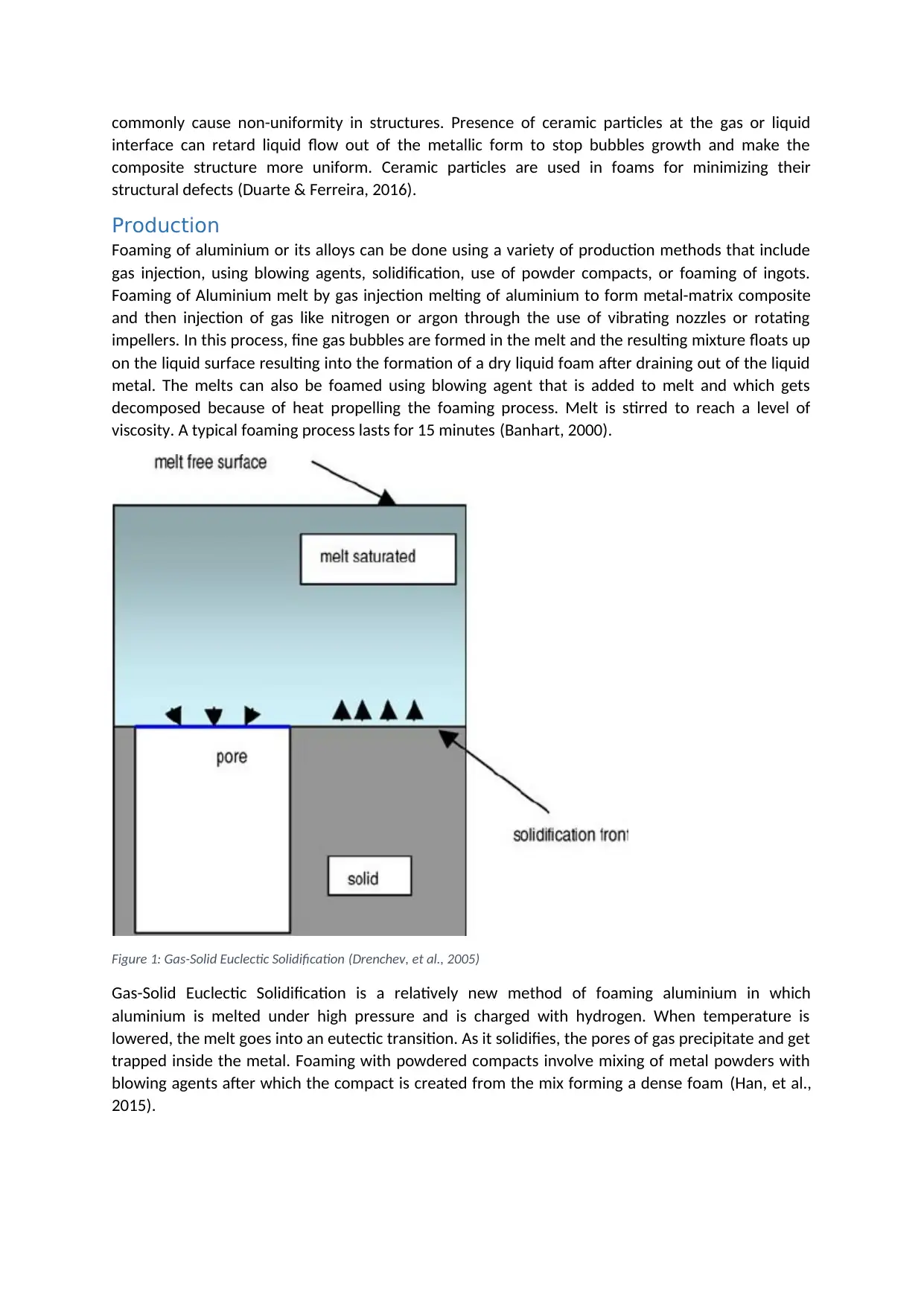
commonly cause non-uniformity in structures. Presence of ceramic particles at the gas or liquid
interface can retard liquid flow out of the metallic form to stop bubbles growth and make the
composite structure more uniform. Ceramic particles are used in foams for minimizing their
structural defects (Duarte & Ferreira, 2016).
Production
Foaming of aluminium or its alloys can be done using a variety of production methods that include
gas injection, using blowing agents, solidification, use of powder compacts, or foaming of ingots.
Foaming of Aluminium melt by gas injection melting of aluminium to form metal-matrix composite
and then injection of gas like nitrogen or argon through the use of vibrating nozzles or rotating
impellers. In this process, fine gas bubbles are formed in the melt and the resulting mixture floats up
on the liquid surface resulting into the formation of a dry liquid foam after draining out of the liquid
metal. The melts can also be foamed using blowing agent that is added to melt and which gets
decomposed because of heat propelling the foaming process. Melt is stirred to reach a level of
viscosity. A typical foaming process lasts for 15 minutes (Banhart, 2000).
Figure 1: Gas-Solid Euclectic Solidification (Drenchev, et al., 2005)
Gas-Solid Euclectic Solidification is a relatively new method of foaming aluminium in which
aluminium is melted under high pressure and is charged with hydrogen. When temperature is
lowered, the melt goes into an eutectic transition. As it solidifies, the pores of gas precipitate and get
trapped inside the metal. Foaming with powdered compacts involve mixing of metal powders with
blowing agents after which the compact is created from the mix forming a dense foam (Han, et al.,
2015).
interface can retard liquid flow out of the metallic form to stop bubbles growth and make the
composite structure more uniform. Ceramic particles are used in foams for minimizing their
structural defects (Duarte & Ferreira, 2016).
Production
Foaming of aluminium or its alloys can be done using a variety of production methods that include
gas injection, using blowing agents, solidification, use of powder compacts, or foaming of ingots.
Foaming of Aluminium melt by gas injection melting of aluminium to form metal-matrix composite
and then injection of gas like nitrogen or argon through the use of vibrating nozzles or rotating
impellers. In this process, fine gas bubbles are formed in the melt and the resulting mixture floats up
on the liquid surface resulting into the formation of a dry liquid foam after draining out of the liquid
metal. The melts can also be foamed using blowing agent that is added to melt and which gets
decomposed because of heat propelling the foaming process. Melt is stirred to reach a level of
viscosity. A typical foaming process lasts for 15 minutes (Banhart, 2000).
Figure 1: Gas-Solid Euclectic Solidification (Drenchev, et al., 2005)
Gas-Solid Euclectic Solidification is a relatively new method of foaming aluminium in which
aluminium is melted under high pressure and is charged with hydrogen. When temperature is
lowered, the melt goes into an eutectic transition. As it solidifies, the pores of gas precipitate and get
trapped inside the metal. Foaming with powdered compacts involve mixing of metal powders with
blowing agents after which the compact is created from the mix forming a dense foam (Han, et al.,
2015).
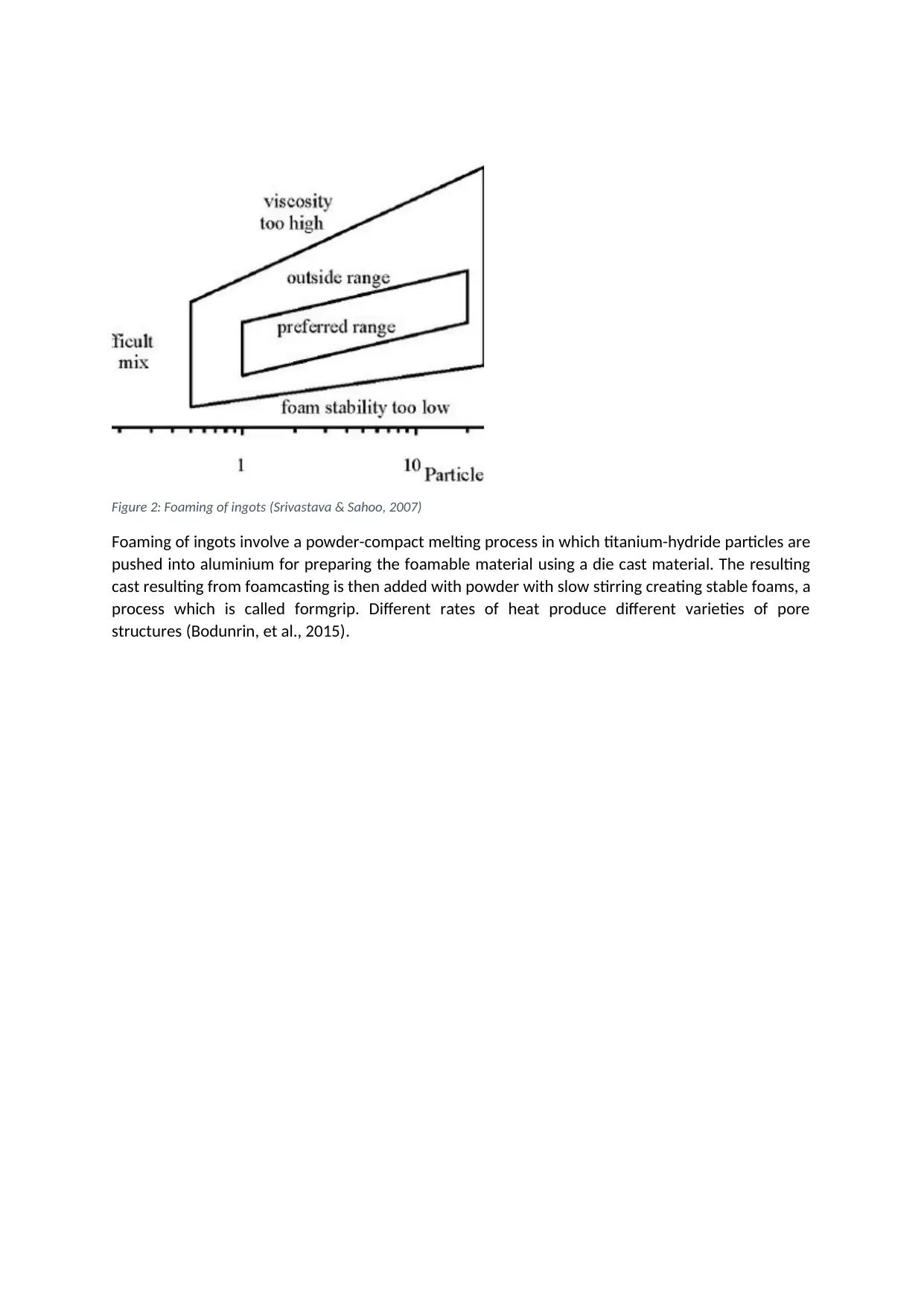
Figure 2: Foaming of ingots (Srivastava & Sahoo, 2007)
Foaming of ingots involve a powder-compact melting process in which titanium-hydride particles are
pushed into aluminium for preparing the foamable material using a die cast material. The resulting
cast resulting from foamcasting is then added with powder with slow stirring creating stable foams, a
process which is called formgrip. Different rates of heat produce different varieties of pore
structures (Bodunrin, et al., 2015).
Foaming of ingots involve a powder-compact melting process in which titanium-hydride particles are
pushed into aluminium for preparing the foamable material using a die cast material. The resulting
cast resulting from foamcasting is then added with powder with slow stirring creating stable foams, a
process which is called formgrip. Different rates of heat produce different varieties of pore
structures (Bodunrin, et al., 2015).
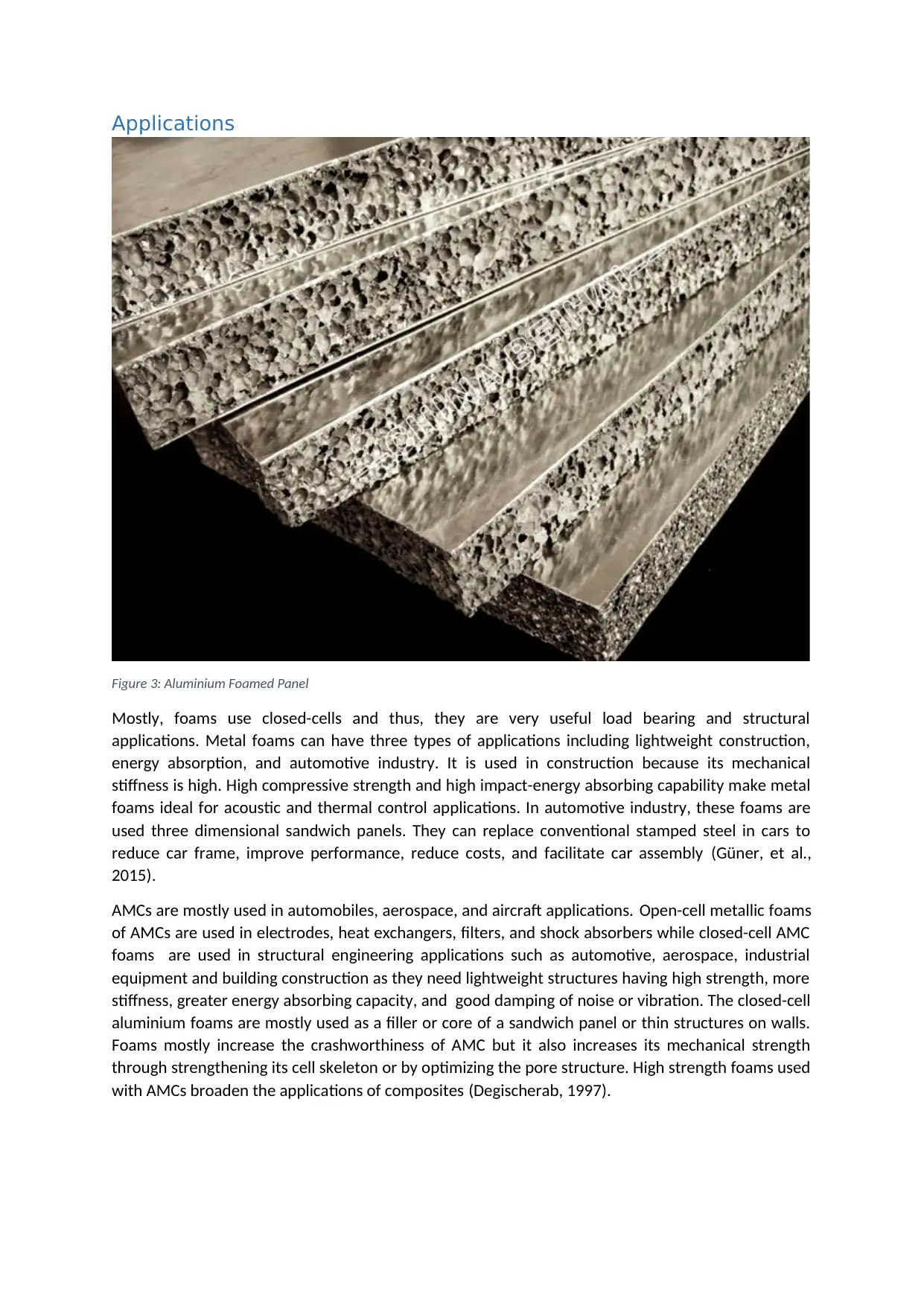
Applications
Figure 3: Aluminium Foamed Panel
Mostly, foams use closed-cells and thus, they are very useful load bearing and structural
applications. Metal foams can have three types of applications including lightweight construction,
energy absorption, and automotive industry. It is used in construction because its mechanical
stiffness is high. High compressive strength and high impact-energy absorbing capability make metal
foams ideal for acoustic and thermal control applications. In automotive industry, these foams are
used three dimensional sandwich panels. They can replace conventional stamped steel in cars to
reduce car frame, improve performance, reduce costs, and facilitate car assembly (Güner, et al.,
2015).
AMCs are mostly used in automobiles, aerospace, and aircraft applications. Open-cell metallic foams
of AMCs are used in electrodes, heat exchangers, filters, and shock absorbers while closed-cell AMC
foams are used in structural engineering applications such as automotive, aerospace, industrial
equipment and building construction as they need lightweight structures having high strength, more
stiffness, greater energy absorbing capacity, and good damping of noise or vibration. The closed-cell
aluminium foams are mostly used as a filler or core of a sandwich panel or thin structures on walls.
Foams mostly increase the crashworthiness of AMC but it also increases its mechanical strength
through strengthening its cell skeleton or by optimizing the pore structure. High strength foams used
with AMCs broaden the applications of composites (Degischerab, 1997).
Figure 3: Aluminium Foamed Panel
Mostly, foams use closed-cells and thus, they are very useful load bearing and structural
applications. Metal foams can have three types of applications including lightweight construction,
energy absorption, and automotive industry. It is used in construction because its mechanical
stiffness is high. High compressive strength and high impact-energy absorbing capability make metal
foams ideal for acoustic and thermal control applications. In automotive industry, these foams are
used three dimensional sandwich panels. They can replace conventional stamped steel in cars to
reduce car frame, improve performance, reduce costs, and facilitate car assembly (Güner, et al.,
2015).
AMCs are mostly used in automobiles, aerospace, and aircraft applications. Open-cell metallic foams
of AMCs are used in electrodes, heat exchangers, filters, and shock absorbers while closed-cell AMC
foams are used in structural engineering applications such as automotive, aerospace, industrial
equipment and building construction as they need lightweight structures having high strength, more
stiffness, greater energy absorbing capacity, and good damping of noise or vibration. The closed-cell
aluminium foams are mostly used as a filler or core of a sandwich panel or thin structures on walls.
Foams mostly increase the crashworthiness of AMC but it also increases its mechanical strength
through strengthening its cell skeleton or by optimizing the pore structure. High strength foams used
with AMCs broaden the applications of composites (Degischerab, 1997).
Secure Best Marks with AI Grader
Need help grading? Try our AI Grader for instant feedback on your assignments.
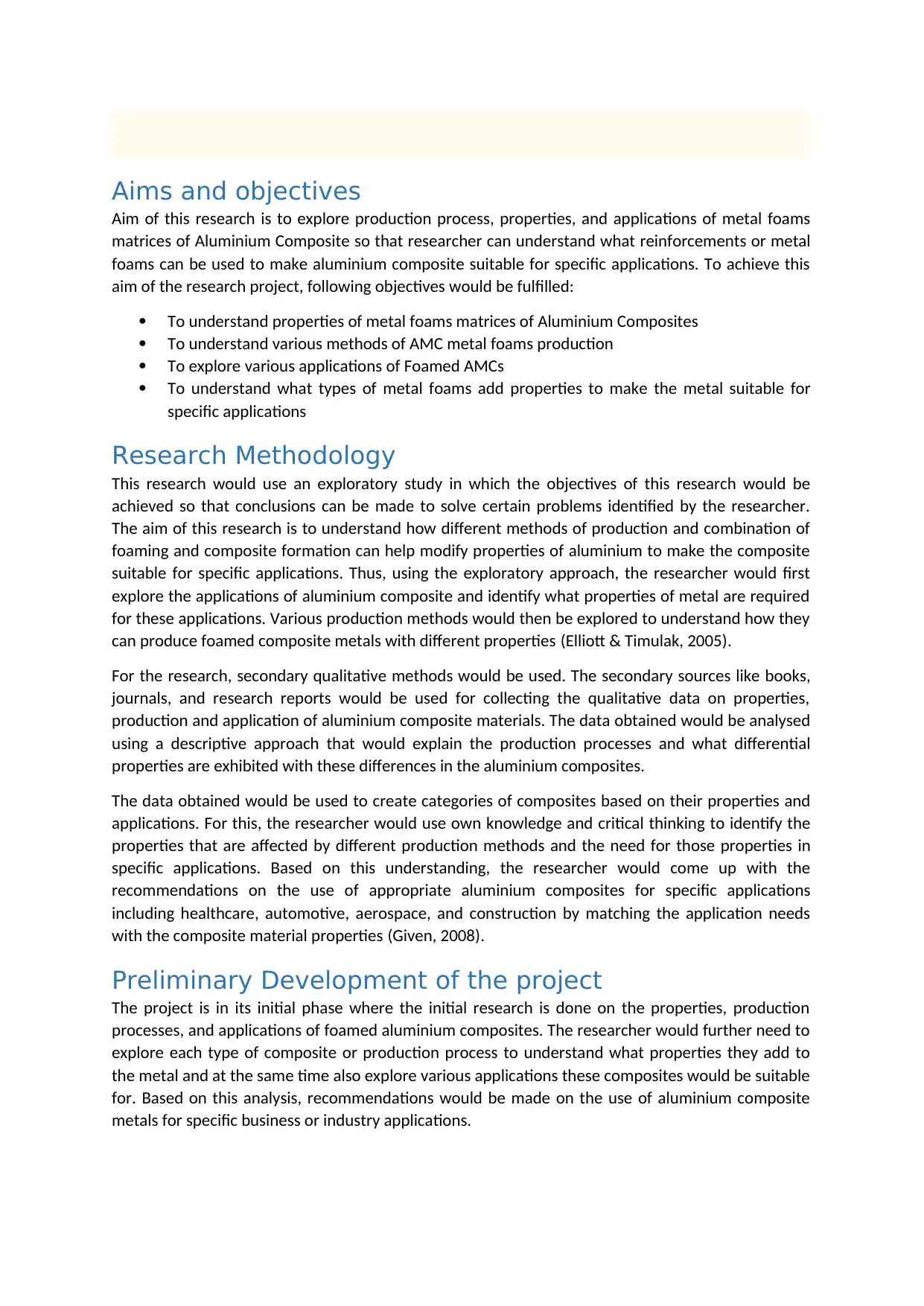
Aims and objectives
Aim of this research is to explore production process, properties, and applications of metal foams
matrices of Aluminium Composite so that researcher can understand what reinforcements or metal
foams can be used to make aluminium composite suitable for specific applications. To achieve this
aim of the research project, following objectives would be fulfilled:
To understand properties of metal foams matrices of Aluminium Composites
To understand various methods of AMC metal foams production
To explore various applications of Foamed AMCs
To understand what types of metal foams add properties to make the metal suitable for
specific applications
Research Methodology
This research would use an exploratory study in which the objectives of this research would be
achieved so that conclusions can be made to solve certain problems identified by the researcher.
The aim of this research is to understand how different methods of production and combination of
foaming and composite formation can help modify properties of aluminium to make the composite
suitable for specific applications. Thus, using the exploratory approach, the researcher would first
explore the applications of aluminium composite and identify what properties of metal are required
for these applications. Various production methods would then be explored to understand how they
can produce foamed composite metals with different properties (Elliott & Timulak, 2005).
For the research, secondary qualitative methods would be used. The secondary sources like books,
journals, and research reports would be used for collecting the qualitative data on properties,
production and application of aluminium composite materials. The data obtained would be analysed
using a descriptive approach that would explain the production processes and what differential
properties are exhibited with these differences in the aluminium composites.
The data obtained would be used to create categories of composites based on their properties and
applications. For this, the researcher would use own knowledge and critical thinking to identify the
properties that are affected by different production methods and the need for those properties in
specific applications. Based on this understanding, the researcher would come up with the
recommendations on the use of appropriate aluminium composites for specific applications
including healthcare, automotive, aerospace, and construction by matching the application needs
with the composite material properties (Given, 2008).
Preliminary Development of the project
The project is in its initial phase where the initial research is done on the properties, production
processes, and applications of foamed aluminium composites. The researcher would further need to
explore each type of composite or production process to understand what properties they add to
the metal and at the same time also explore various applications these composites would be suitable
for. Based on this analysis, recommendations would be made on the use of aluminium composite
metals for specific business or industry applications.
Aim of this research is to explore production process, properties, and applications of metal foams
matrices of Aluminium Composite so that researcher can understand what reinforcements or metal
foams can be used to make aluminium composite suitable for specific applications. To achieve this
aim of the research project, following objectives would be fulfilled:
To understand properties of metal foams matrices of Aluminium Composites
To understand various methods of AMC metal foams production
To explore various applications of Foamed AMCs
To understand what types of metal foams add properties to make the metal suitable for
specific applications
Research Methodology
This research would use an exploratory study in which the objectives of this research would be
achieved so that conclusions can be made to solve certain problems identified by the researcher.
The aim of this research is to understand how different methods of production and combination of
foaming and composite formation can help modify properties of aluminium to make the composite
suitable for specific applications. Thus, using the exploratory approach, the researcher would first
explore the applications of aluminium composite and identify what properties of metal are required
for these applications. Various production methods would then be explored to understand how they
can produce foamed composite metals with different properties (Elliott & Timulak, 2005).
For the research, secondary qualitative methods would be used. The secondary sources like books,
journals, and research reports would be used for collecting the qualitative data on properties,
production and application of aluminium composite materials. The data obtained would be analysed
using a descriptive approach that would explain the production processes and what differential
properties are exhibited with these differences in the aluminium composites.
The data obtained would be used to create categories of composites based on their properties and
applications. For this, the researcher would use own knowledge and critical thinking to identify the
properties that are affected by different production methods and the need for those properties in
specific applications. Based on this understanding, the researcher would come up with the
recommendations on the use of appropriate aluminium composites for specific applications
including healthcare, automotive, aerospace, and construction by matching the application needs
with the composite material properties (Given, 2008).
Preliminary Development of the project
The project is in its initial phase where the initial research is done on the properties, production
processes, and applications of foamed aluminium composites. The researcher would further need to
explore each type of composite or production process to understand what properties they add to
the metal and at the same time also explore various applications these composites would be suitable
for. Based on this analysis, recommendations would be made on the use of aluminium composite
metals for specific business or industry applications.
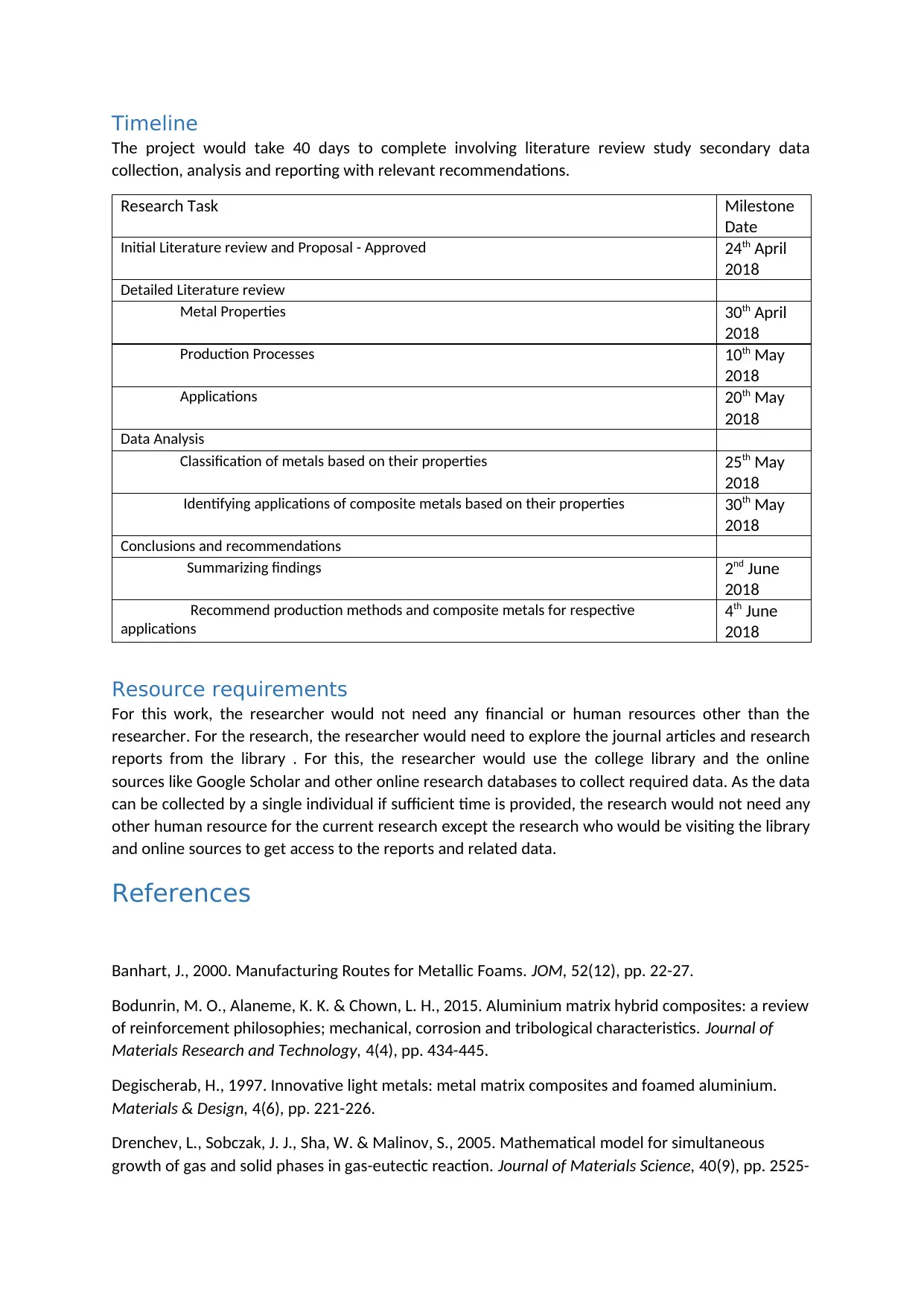
Timeline
The project would take 40 days to complete involving literature review study secondary data
collection, analysis and reporting with relevant recommendations.
Research Task Milestone
Date
Initial Literature review and Proposal - Approved 24th April
2018
Detailed Literature review
Metal Properties 30th April
2018
Production Processes 10th May
2018
Applications 20th May
2018
Data Analysis
Classification of metals based on their properties 25th May
2018
Identifying applications of composite metals based on their properties 30th May
2018
Conclusions and recommendations
Summarizing findings 2nd June
2018
Recommend production methods and composite metals for respective
applications
4th June
2018
Resource requirements
For this work, the researcher would not need any financial or human resources other than the
researcher. For the research, the researcher would need to explore the journal articles and research
reports from the library . For this, the researcher would use the college library and the online
sources like Google Scholar and other online research databases to collect required data. As the data
can be collected by a single individual if sufficient time is provided, the research would not need any
other human resource for the current research except the research who would be visiting the library
and online sources to get access to the reports and related data.
References
Banhart, J., 2000. Manufacturing Routes for Metallic Foams. JOM, 52(12), pp. 22-27.
Bodunrin, M. O., Alaneme, K. K. & Chown, L. H., 2015. Aluminium matrix hybrid composites: a review
of reinforcement philosophies; mechanical, corrosion and tribological characteristics. Journal of
Materials Research and Technology, 4(4), pp. 434-445.
Degischerab, H., 1997. Innovative light metals: metal matrix composites and foamed aluminium.
Materials & Design, 4(6), pp. 221-226.
Drenchev, L., Sobczak, J. J., Sha, W. & Malinov, S., 2005. Mathematical model for simultaneous
growth of gas and solid phases in gas-eutectic reaction. Journal of Materials Science, 40(9), pp. 2525-
The project would take 40 days to complete involving literature review study secondary data
collection, analysis and reporting with relevant recommendations.
Research Task Milestone
Date
Initial Literature review and Proposal - Approved 24th April
2018
Detailed Literature review
Metal Properties 30th April
2018
Production Processes 10th May
2018
Applications 20th May
2018
Data Analysis
Classification of metals based on their properties 25th May
2018
Identifying applications of composite metals based on their properties 30th May
2018
Conclusions and recommendations
Summarizing findings 2nd June
2018
Recommend production methods and composite metals for respective
applications
4th June
2018
Resource requirements
For this work, the researcher would not need any financial or human resources other than the
researcher. For the research, the researcher would need to explore the journal articles and research
reports from the library . For this, the researcher would use the college library and the online
sources like Google Scholar and other online research databases to collect required data. As the data
can be collected by a single individual if sufficient time is provided, the research would not need any
other human resource for the current research except the research who would be visiting the library
and online sources to get access to the reports and related data.
References
Banhart, J., 2000. Manufacturing Routes for Metallic Foams. JOM, 52(12), pp. 22-27.
Bodunrin, M. O., Alaneme, K. K. & Chown, L. H., 2015. Aluminium matrix hybrid composites: a review
of reinforcement philosophies; mechanical, corrosion and tribological characteristics. Journal of
Materials Research and Technology, 4(4), pp. 434-445.
Degischerab, H., 1997. Innovative light metals: metal matrix composites and foamed aluminium.
Materials & Design, 4(6), pp. 221-226.
Drenchev, L., Sobczak, J. J., Sha, W. & Malinov, S., 2005. Mathematical model for simultaneous
growth of gas and solid phases in gas-eutectic reaction. Journal of Materials Science, 40(9), pp. 2525-
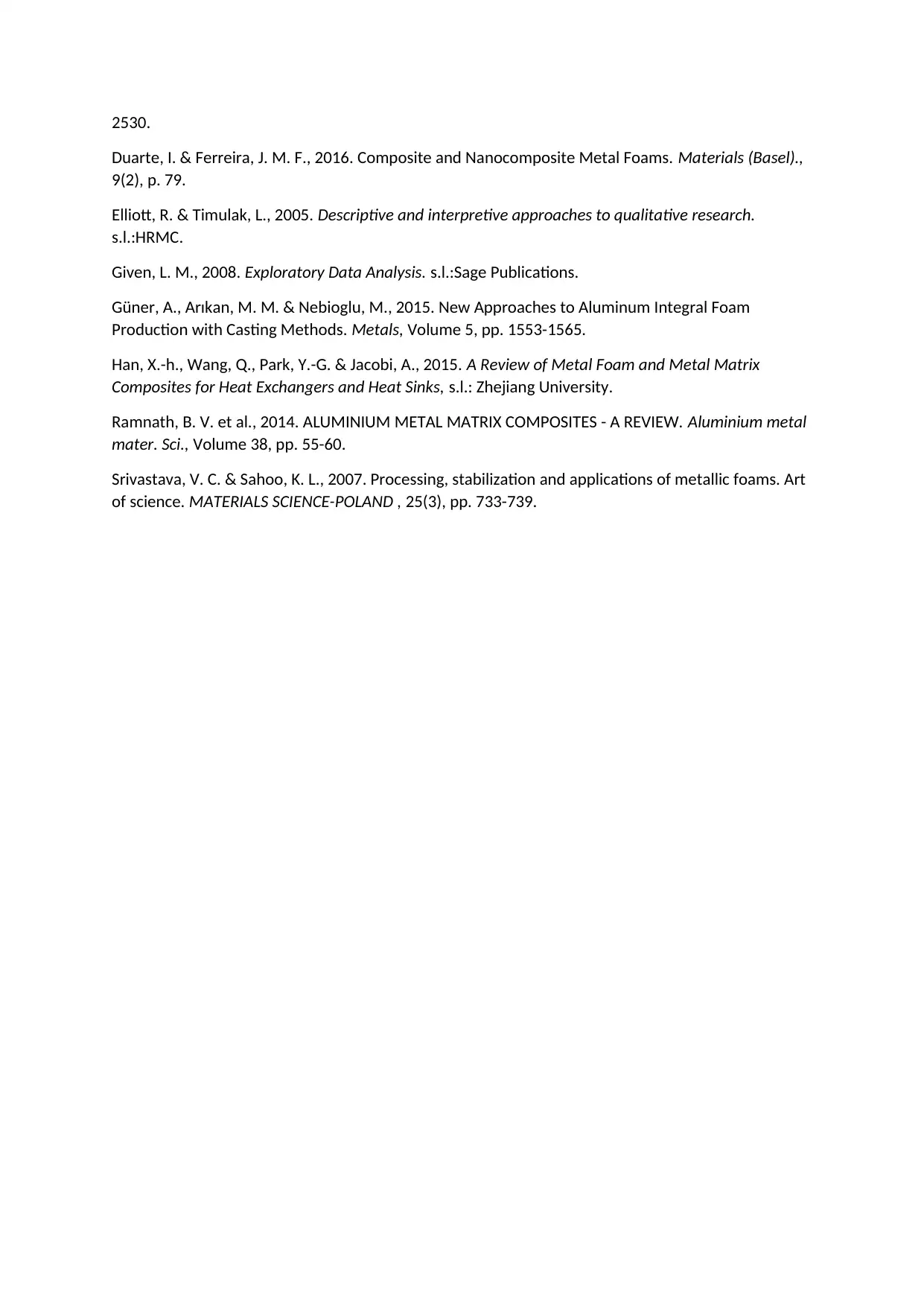
2530.
Duarte, I. & Ferreira, J. M. F., 2016. Composite and Nanocomposite Metal Foams. Materials (Basel).,
9(2), p. 79.
Elliott, R. & Timulak, L., 2005. Descriptive and interpretive approaches to qualitative research.
s.l.:HRMC.
Given, L. M., 2008. Exploratory Data Analysis. s.l.:Sage Publications.
Güner, A., Arıkan, M. M. & Nebioglu, M., 2015. New Approaches to Aluminum Integral Foam
Production with Casting Methods. Metals, Volume 5, pp. 1553-1565.
Han, X.-h., Wang, Q., Park, Y.-G. & Jacobi, A., 2015. A Review of Metal Foam and Metal Matrix
Composites for Heat Exchangers and Heat Sinks, s.l.: Zhejiang University.
Ramnath, B. V. et al., 2014. ALUMINIUM METAL MATRIX COMPOSITES - A REVIEW. Aluminium metal
mater. Sci., Volume 38, pp. 55-60.
Srivastava, V. C. & Sahoo, K. L., 2007. Processing, stabilization and applications of metallic foams. Art
of science. MATERIALS SCIENCE-POLAND , 25(3), pp. 733-739.
Duarte, I. & Ferreira, J. M. F., 2016. Composite and Nanocomposite Metal Foams. Materials (Basel).,
9(2), p. 79.
Elliott, R. & Timulak, L., 2005. Descriptive and interpretive approaches to qualitative research.
s.l.:HRMC.
Given, L. M., 2008. Exploratory Data Analysis. s.l.:Sage Publications.
Güner, A., Arıkan, M. M. & Nebioglu, M., 2015. New Approaches to Aluminum Integral Foam
Production with Casting Methods. Metals, Volume 5, pp. 1553-1565.
Han, X.-h., Wang, Q., Park, Y.-G. & Jacobi, A., 2015. A Review of Metal Foam and Metal Matrix
Composites for Heat Exchangers and Heat Sinks, s.l.: Zhejiang University.
Ramnath, B. V. et al., 2014. ALUMINIUM METAL MATRIX COMPOSITES - A REVIEW. Aluminium metal
mater. Sci., Volume 38, pp. 55-60.
Srivastava, V. C. & Sahoo, K. L., 2007. Processing, stabilization and applications of metallic foams. Art
of science. MATERIALS SCIENCE-POLAND , 25(3), pp. 733-739.
1 out of 7
Related Documents
Your All-in-One AI-Powered Toolkit for Academic Success.
+13062052269
info@desklib.com
Available 24*7 on WhatsApp / Email
![[object Object]](/_next/static/media/star-bottom.7253800d.svg)
Unlock your academic potential
© 2024 | Zucol Services PVT LTD | All rights reserved.




